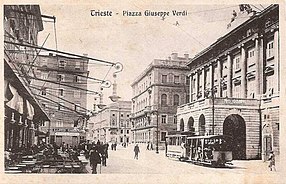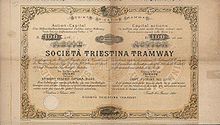Trieste tram
| Trieste tram | |
|---|---|
| Tram on the Giuseppe-Verdi-Platz | |
| Basic information | |
| Country | Italy |
| city | Trieste |
| opening | 1876 |
| electrification | October 2, 1900 |
| Shutdown | March 31, 1970 |
| Infrastructure | |
| Formerly the largest route |
16 km |
| Gauge | 1445 mm |
| Power system | 600 V = |
| business | |
| Lines | 10 (1925) |
| Trieste tram network before 1935 | |
The Trieste tram was a rail-bound local transport system in Trieste , normal-gauge operation existed between 1876 and 1970.
history
The Trieste tram existed from 1876 to 1970 as an inner-city local means of transport. The meter-gauge mountain railway from Trieste to Opicina still exists today, but has always been operated independently of the actual Trieste tram.
Before the First World War
In 1875 the Società Triestina Tramway was founded as a public limited company. The company's headquarters were in Trieste. The share capital was six million crowns . Since March 30, 1876, the company offered a horse-drawn tram service on standard gauge tracks . On March 31, 1899, the company received an operating license, which was published in the Reichsgesetzblatt . The first electrified line was opened on October 2, 1900.
The contact wire voltage was 600 volts. In 1921 the tram was transferred to a municipal operation ( l'Azienda Comunale Tranvie Municipali ). The company was not only active on the tram network in Trieste, but also operated the Lviv tram network in Galicia . This part of the business was sold to the state capital Lviv around 1906.
After the First World War
On July 16, 1934, the city of Trieste transferred its business operations to the company ACEGAT (l'Azienda Comunale dei servizi Elettricità, Gas, Acqua e Tranvie, German: municipal service company for electricity, gas, water and trams). In the heyday of the company, the Trieste tram network was 16 kilometers long. The last section with line 9 was shut down on March 31, 1970.
vehicles
The first electric vehicles came from the Vienna branch of the Union-Elektricitäts-Gesellschaft . Later deliveries came from the Grazer Waggonfabrik as well as from Officine Meccaniche della Stanga and other Italian manufacturers.
After the shutdown, vehicles came to various Italian tram companies, including a. to Rome . Some trams from Trieste are preserved in the Trieste Railway Museum. Another tram is in the care of the tram fans of Turin .
Route network
In the concession according to the Reichsgesetzblatt, the following lines are given:
- 1, Boschetto - San Andrea with the Bagno Fontana junction
- 2, Piazza dei Negozianti - Barcola with the Punto franco junction
- 3, Piazza della Stazione - Via del Torrente
- 4, Via San Antonio - Piazza della Caserma
- 5, Piazza delle Legna - Barriera vecchia
- 6, San Andrea - Servola
- 7, Piazza della Caserma - Via di Rojano
- 8, Ponte della Fabbra - Via Conti
An Italian travel guide from 1925 lists as lines:
- Line 1: S.Sabba - Piazza della Libertà
- Line 2: Boschetto - Servola e viceversa
- Line 3: Boschetto - Campo Marzio (S.Andrea)
- Line 4: Piazza Garibaldi - Campo Marzio (S.Andrea)
- Line 5: Piazza del Perugino - Roiano
- Line 6: Portici di Chiozza - Barcola
- Line 7: Boschetto - Stazione Centrale
- Line 8: Interstazionale tra Campo Marzio e Centrale
- Line 9: Piazza della Borsa - via F.Severo (n.25-Casa degli Sposi)
- Linea 10: Boschetto - Broletto (S.Andrea)
Web links
- Official website of the Trieste Transport Authority
- German-language website about traffic in Friuli-Venezia Giulia
- Little chronicle. […] Electric subway in Trieste. Neue Freie Presse, Abendblatt, February 23, 1901, p. 1, bottom center
- Announcement by the Ministry of Railways regarding the concession of a network of standard-gauge small railroad lines to be operated with electric power in Trieste (Reichsgesetzblatt of April 11, 1899)
Individual evidence
- ^ Guida illustrata descrittiva della città di Trieste principali località e grotte della Venezia Giulia, ed. "Precisa" Trieste





